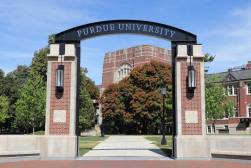Campuses mostly back to normal, but university enrollment is still falling

The college experience at many institutions is now more or less the same as it was pre-pandemic, but student numbers have still not recovered, according to new data published Thursday by the National Student Clearinghouse Research Center.
Undergraduate and graduate student numbers fell by 1.1% this fall semester compared to last year, according to the report. The preliminary fall data is based on 10.3 million undergraduate and graduate students, as reported by 63% of colleges and universities that get federal funding.
While the rate of enrollment decline has slowed since the peak of pandemic disruption in fall 2020, student numbers have fallen overall by 3.2% over the past two years — a trend that is concerning to higher education experts.
“After two straight years of historically large losses, it is particularly troubling that numbers are still falling, especially among freshmen,” Doug Shapiro, the research center’s executive director, said in a press release. “Although the decline has slowed and there are some bright spots, a path back to pre-pandemic enrolment levels is growing further out of reach.”
In previous economic downturns, higher education institutions saw an increase in student enrollment as job scarcity drove people back to college. That pattern of counter-cyclical enrollment may have come into play last year, with graduate enrollment increasing by 2.7% compared to 2020. This year, graduate enrollment fell by 1%, but is still above pre-pandemic levels.
The number of first-year undergraduate students declined by 1.5% overall this year compared to 2021. Across four-year institutions, private nonprofits dropped 3.1%, publics lost 2.4%, and private for-profits fell by 0.9%. Highly selective institutions saw the largest enrollment decline, with undergrad numbers decreasing by 5.6% this year following a 10.7% gain last year.
The picture is a little brighter at two-year institutions, historically Black universities and colleges and online colleges. Community colleges saw a 0.9% increase in undergraduate enrollment this year, contributing to overall student growth of 1% over the past two years. HBCU undergraduate enrollment grew by 2.5% this year, with a 6.6% increase in the number of first-year students.
Predominantly online institutions saw a 3.2% increase in undergraduate students this year, with students aged 18-24 increasingly choosing to study online, suggesting that younger students are increasingly open to the idea of studying from home and forgoing the traditional college experience, said Shapiro. It’s unclear whether this shift in attitude is due to exposure to online learning or because more young people may be juggling part-time employment alongside their studies.
The subjects that students are choosing to study is also changing, Shapiro said. The number of students majoring in computer science at the associate and bachelor degree level increased by 10% this year, while health-related majors saw declines of 5%.




